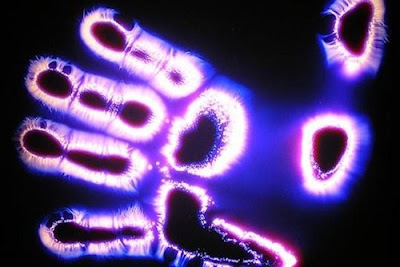Scientists around the world were amazed by Kirlian's discovery, and especially by its proposed practical application - the early detection of both physical and mentl diseases through an analysis of the colors of a patient's aura, which Kirlian referred to as 'bioluminescence'.
Hospitals soon began equipping themselves with devices designed to measure the Kirlian effect. Here's how one observer described an image produced by a Kirlian device:
"... fireworks exploding against a dark blue background, sheaths of multicolored sparks in the midst of flames and dazzling flashes. Some light patterns had the regular glow of candles, while others were explosions of blinding light, which gradually faded. Some flew by like flaming meteors. In some areas we could see dark filaments of vapor floating in space. Random flashes outlined a sparkling, labyrinth-like structure resembling a spacecraft in search of new galaxies."This was no dream imagery, or the product of some poet's unbridled imagination, but the report of a Russian academic after witnessing the bioplasmic aura produced by a human hand, as seen through a Kirlian photographic device.
The year is 1939. A technician in the city of Krasnodar is called in to repair a high frequency machine used for electrotherapy. He notices a brilliant glare between the patient's skin and an electrode linked to the machine. He tries to photograph the phenomenon, which turns out to be a variation of something called the corona effect, an occurrence that is well known in the field of electronics.
First discovery: the corona photographed in this way varies in accordance with the level of vital energy of the body emitting it. Kirlian could actually see the energy stored in plants and animals. He soon realized that diseased plants and animals emitted less light, while dead plants and animals emitted no light at all. Intense bioluminescent activity surrounds every living entity, while dead entities produce no bioluminescence whatever.
Second discovery: the existence of a kind of energy body, composed of bioplasm, which is closely linked to the physical body. If you take a leaf and cut away a small part, the energy image emitted by the leaf remains intact, although the part that was amputated become less bright. This phantom image of the missing part of the leaf confirms the theory of an energy body, and may explain why many amputees continue to experience perceptions from missing limbs, as if they had a phantom limb (no other satisfactory explanation for this phenomenon has been offered to date).
Third discovery: Examining two leaves picked from the same species of tree at the same time, Kirlian noticed a difference between theme. One leaf emitted small points of flame, a shape he had never seen before.
He learned that although both leaves came from the same type of tree, one of the trees had been inoculated against a serious form of disease.
His conclusion: Long before the disease manifested it self in the body of the tree. it showed up as a clear pattern in the tree's energy field.
Further research showed that the phenomenon was applicable to humans as well as plants, paving the way for the medical application of the Kirlian technique as a diagnostic tool.
After examining a series of Kirlian phorographs, a surgeon in Leningrad, M.K. Gaikine, wondered if it would be possible to relate the photographic images to the 700 or so acupuncture points used by practitioners of Chinese medicine and its variations. His suggestion turned out to be very useful, especially for practitioners of acupuncture, who were finally able to offer scientific proof of the effectiveness of their technique. As it turned out, the energy centers designated in acupuncture diagrams correspond more or less exactly to the dense areas of light, called 'sunspots', visible in Kirlian photographs.
Using Kirlian's procedure, Dr. Gaikine and a Leningrad engineer were able to develope a device that could detect the location of acupuncture points to within a tenth of a millimeter (the device was included as one of the official Russian exhibits at the 1967 World's Fair held in Montreal, Canada).
by:
Christian H. Godefroy
He is a specialist in positive thinking and auto-suggestion. he has given training seminars to over 6,000 senior company personnel arround the world on self-confidence, communication and relaxation. Today he concentrates on publishing books about personal and professional success and about health and runs his own highly successful publishing companies in France and Switzerland.


No comments :
Post a Comment